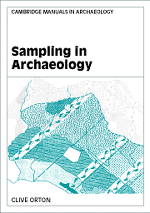Book contents
- Frontmatter
- Contents
- List of illustrations
- List of tables
- Acknowledgements
- 1 All the world's a sample
- 2 A little of what you fancy?
- 3 If this is the sample, what was the population?
- 4 Covering the ground
- 5 What's in a site?
- 6 The answer lies in the soil
- 7 ‘But many sanguine people hope, to see them through a microscope’
- 8 ‘In its depths, what treasures’
- 9 Beyond random sampling
- Appendix
- Bibliography
- Index
3 - If this is the sample, what was the population?
Published online by Cambridge University Press: 05 June 2012
- Frontmatter
- Contents
- List of illustrations
- List of tables
- Acknowledgements
- 1 All the world's a sample
- 2 A little of what you fancy?
- 3 If this is the sample, what was the population?
- 4 Covering the ground
- 5 What's in a site?
- 6 The answer lies in the soil
- 7 ‘But many sanguine people hope, to see them through a microscope’
- 8 ‘In its depths, what treasures’
- 9 Beyond random sampling
- Appendix
- Bibliography
- Index
Summary
Introduction
Before moving on to look at the applications of statistical sampling theory and practice at a range of archaeological scales (chapters 4–8), we first make a diversion into archaeological theory. In this chapter we shall consider what insights the statistical theory of chapter 2 might be able to give us into the broader question of archaeological inference, that is, of inferring past activities from present-day archaeological remains. Archaeological inference is of course an enormous topic (see Sullivan 1978 for an overview; for a more recent view see Adams 1991), deserving of a book in itself, and it is not my intention to cover its full breadth here. But an approach grounded in statistical theory may at least help to clarify some issues, and to suggest appropriate methods of recording and analysis in certain situations.
It is a truism that archaeological remains, whether in the form of features or of artefacts, are rarely the totality originally created by, or used in, the activities that they now represent. In a sense, they are a ‘sample’ from some original but unknown ‘population’. For example, coins found on the site of a Roman town may be regarded as a sort of sample of those in circulation at that location at a certain period, or the sherds from a waster dump at a pottery production site may be regarded as another sort of sample of the pottery produced there. The big question is: what sort of a sample?
- Type
- Chapter
- Information
- Sampling in Archaeology , pp. 40 - 66Publisher: Cambridge University PressPrint publication year: 2000



